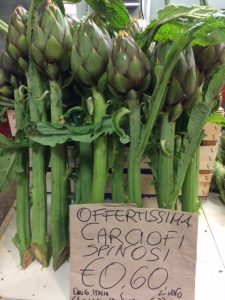This a monthly series which I have been publishing for years. You can subscribe here, to get the latest cheese delivered directly on to your screen.
In Sardinia three things are really abundant: sheep (three million of them, who get along pretty well with about half as many human beings), thistles (in an amazing number of varieties, from edible artichokes to just beautiful but pretty thorny), and stones (which in the course of the millennia have been arranged to all kinds of things, such as round Nuraghe temples and endless walls, but there are still plenty left lying around).

Nevertheless, or probably rather because of this, Sardinia is a truly beautiful island, with so many sides to it that take a while to discover and register (such as the vineyards, almost hidden away amongst the hills and terraces and cliffs, even though wine plays an important role here – hooray!). The sheep however are very present, and the island’s best known cheese obviously is pecorino, again in a great number of variations. But there are also cows and goats, all like the sheep a little smaller than on the mainland, a little wilder, a little shaggy and shy.

During my recent (needless to say way too short) trip to Sardinia I wanted to learn as much as possible about the background and history of Sardinian cheese in general. But above all I was on a mission to find the Callu de cabreddu (or crabettu), literally goat kid’s rennet. For me this is the ur-cheese of all cheeses. I imagine something like this in prehistoric times: a shepherd kills a young goat, which has just suckled at its mother’s tits, and he discovers a whitish, curdled substance in its fourth stomach. He is curious, lets the stuff dry a little… voilà. The idea of cheese was in the world. Today Callu is made by filling a cleaned kid’s abomasum (that is that fourth stomach where the rennet is formed when the young animals are still suckling and need to digest the milk) with raw goat’s milk.

It is only produced in Ogliastra on the east coast, where we duly spent a whole Sunday chasing it. After a real odyssey and a great number of phone calls (Sardinians are very friendly people who love to chat and talk), we learnt that this was apparently a bad year for Callu and very few had been produced. However, perhaps, that particular shop might have some… but it was closed. We rang anyhow, and a friendly lady let us in. AND she had Callu! Which compared to other cheeses is truly expensive. But who cares. Her Callu were very fresh, still soft, not even four weeks old (they say Callu can mature up to four months). Very happy we drove on with our purchase – we hadn’t tasted it yet, but after all you can’t have your cheese and eat it, that would have to wait till the HeinzelCheeseTalk in Berlin.

At night we looked for a hotel in Lanusei, asked for a recommendation where to have dinner, were sent to a modest pizzeria around the corner, discussed the daily offers with the friendly waitress – and ended up with a cheese plate containing, amongst others, Callu! Very creamy and dense and intense (doubtlessly due to the relatively high amount of rennet and the natural presence of whey) the fatty acids almost biting in the finish. Not necessarily made for consuming in large dollops…
When we studied the small white label on our own Callu we discovered that it declared to be goat’s milk in a lamb’s stomach. Apparently it really wasn’t a good year for goat kids. So we are still very excited about how this will taste – different to the one in Lanusei? In any case the sweet wine to go with it, a Malvasia from beautiful Bosa on the west coast, is chilled and ready.
This a monthly series which I have been publishing for years. You can subscribe here, to get the latest cheese delivered directly on to your screen.
If you enjoyed reading this, you might consider clicking on the button below and supporting me in my work. I’d be more than happy. Thank you.
